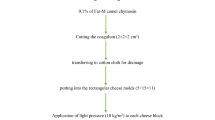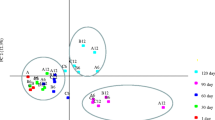Abstract
The effects of black cumin (BC) at 0, 1 or 2% in Erzincan Tulum cheese (Tulum cheese) on its microbiological, chemical and proteolysis properties during ripening were investigated. The addition of BC caused an increase in the dry matter, protein, ash, total nitrogen (TN), water-soluble nitrogen (WSN) (% of TN) (ripening index), 5% phosphotungstic acid soluble nitrogen (PTA-SN) (% of TN), and 12% trichloroacetic acid soluble nitrogen (TCA-SN) (% of TN) concentrations compared to BC-free (control) cheese. Additionally, the addition of BC caused a decrease in coliforms, yeasts & moulds, fat-in-dry matter (FDM), pH, and acidity. The ripening period had an increasing effect on the dry matter, protein, FDM, salt, salt-in-dry matter (SDM), ash, acidity, TN, WSN, PTA-SN and TCA-SN concentrations. In addition, the ripening period had a decreasing effect on coliforms, yeasts & moulds, and pH. The count of Staphylococcus aureus in all Tulum cheeses made of raw sheep’s milk was < 2 log cfu/g, ripening was faster and favourable Tulum cheese was produced. Therefore, 2 months after adding 2% BC to Tulum cheese that was produced using raw sheep milk immediately after milking as the original production method, it was found that Tulum cheese can be consumed more safely than coliform bacteria and yeasts & moulds.

Similar content being viewed by others
References
Anonymous (2015) Turkish food codex, for cheese. Number 2015/6. Official Journal, 29261, Ankara, Turkey
AOAC (1995) Official methods of analysis, vol 2, 16th edn. AOAC International, Arlington, pp 503–515
Cakir Y, Cakmakci S, Hayaloglu AA (2016) The effect of addition of black cumin (Nigella sativa L.) and ripening period on proteolysis, sensory properties and volatile profiles of Erzincan Tulum (Şavak) cheese made from raw Akkaraman sheep’s milk. Small Ruminant Res 134:65–73. https://doi.org/10.1016/j.smallrumres.2015.12.004
Çakmakçı S (2011) Türkiye Peynirleri (Cheeses of Turkey) (19. Bölüm: 585–614). In: Peynir Biliminin Temelleri. (Editörler: AA. Hayaloğlu ve B. Özer), ISBN: 978-605-87976-1-1, SİDAS Medya Ltd. Şti., İzmir, 643 s (in Turkish)
Çakmakçı S, Çakır Y (2011) Black cumin (Nigella sativa L.): composition, its use in food industry and health effects. Academic Food J 9(3):61–69
Cakmakci S, Gurses M, Gundogdu E (2011) The effect of different packaging materials on proteolysis, sensory scores and gross composition of Tulum cheese. Afr J Biotechnol 10:4444–4449. https://doi.org/10.5897/AJB10.2302
Cakmakci S, Cetin B, Gürses M, Dagdemir E, Hayaloglu AA (2012) Morphological, molecular, and mycotoxigenic identification of dominant filamentous fungi from Moldy Civil cheese. J Food Protect 75:2045–2049. https://doi.org/10.4315/0362-028X.JFP-12-107
Centre for Food Safety (2014) Microbiological guidelines for food (for ready-to-eat food in general and specific food items) August 2014 (revised). Risk Assessment Section Centre for Food Safety Food and Environmental Hygiene Department 43/F, Queensway Government Offices, 66 Queensway, Hong Kong
Ceylan ZG, Caglar A, Cakmakci S (2007) Some physicochemical, microbiological, and sensory properties of tulum cheese produced from ewe’s milk via a modified method. Int J Dairy Technol 60:191–197. https://doi.org/10.1111/j.1471-0307.2007.00326.x
Fox PF, Law J, McSweeney PLM, Wallace J (1999) Biochemistry of cheese ripening. In: Fox PF (ed) Cheese: chemistry, physics and microbiology, vol 1. Aspen Publishers, Gaithersburg, pp 389–438
Galli BD, Martin JGP, Silva PPM, Porto E, Spoto MHF (2016) Sensory quality of Camembert-type cheese: relationship between starter cultures and ripening molds. Int J Food Microbiol 234:71–75. https://doi.org/10.1016/j.ijfoodmicro.2016.06.025
Gilliland SE, Sandine WE, Vedamuthu ER (1984) Acid-production micro-organisms. In: Speck ML (ed) Compendium of methods for the microbiological examination of foods. American Public Health Association, Washington, pp 184–194
Guler Z, Uraz T (2003) Proteolytic and lipolytic composition of Tulum cheeses. Milchwissenschaft 58:502–505
Güven M, Konar A (1994) İnek sütlerinden üretilen ve farklı materyallerde olgunlaştırılan Tulum peynirlerinin fiziksel, kimyasal ve duyusal özellikleri. Gıda 19:287–293 (Food, in Turkish)
Harrigan WF (1998) Laboratory methods in food microbiology. Academic Press, San Diego, p 532
Hayaloglu AA, Kirbag S (2007) Microbial quality and presence of moulds in Kuflu cheese. Int J Food Microbiol 115:376–380. https://doi.org/10.1016/j.ijfoodmicro.2006.12.002
Hayaloglu AA, Cakmakci S, Brenchany KC, Deegan KC, McSweeney PLH (2007) Microbiology, biochemistry and volatile composition of Tulum cheese ripened in goat’s skin or plastic bags. J Dairy Sci 90:1102–1121. https://doi.org/10.3168/jds.S0022-0302(07)71597-7
Hayaloglu AA, Brenchany KC, Deegan KC, McSweeney PLH (2008) Characterization of the chemistry, biochemistry and volatile profile of Kuflu cheese, a mould-ripened variety. LWT- Food Sci Technol 41:1323–1334. https://doi.org/10.1016/j.lwt.2007.08.020
IDF (1982) Determination of the total solid content (cheese and processed cheese). International Dairy Federation, IDF Standart 4A, IDF, Brussels, Belgium
IDF (1993) Determination of the nitrogen content (Kjeldahl method) and calculation of the crude protein content. International Dairy Federation, Standard Method 20B: Milk, IDF, Brussels, Belgium
Kuchroo CN, Fox PF (1982) Soluble nitrogen in Cheddar cheese: comparison of extraction procedures. Milchwissenschaft 37:331–335
Kurt A, Çakmakçı S, Çağlar A (2007) Süt ve mamulleri muayeneanaliz metotlari rehberi. Atatürk Univ Ziraat Fak Yay. No: 257, 398 p, Erzurum, Turkey (In Turkish)
Macedo AC, Malcata FX (1997) Secondary proteolysis in Serra cheese during ripening and throughout the cheese-making season. Z. Lebensm Unters Forsch A 204:173–179
Madkor S, Fox PF, Shalabi SI, Metwalli NH (1987) Studies on the ripening of Stilton cheese: proteolysis. Food Chem 25:13–29. https://doi.org/10.1016/0308-8146(87)90050-1
McSweeney PLH, Fox PF (1997) Chemical methods for the characterization of proteolysis in cheese during ripening. Lait 77:41–76
Oluk AC, Güven M, Hayaloglu AA (2014) Influence of exopolysaccharide-producing cultures on the volatile profile and sensory quality of low-fat Tulum cheese during ripening. Int J Dairy Technol 67:265–276. https://doi.org/10.1111/1471-0307.12118
Oner Z, Simsek B, Sagdic O (2003) Determination of some properties of Turkish Tulum cheeses. Milchwissenschaft 58:152–154
Ramadan MF (2007) Nutritional value, functional properties and nutraceutical applications of black cumin (Nigella sativa L.): an overview. Int J Food Sci Technol 42:1208–1218. https://doi.org/10.1111/j.1365-2621.2006.01417.x
Salem ML (2005) Immunomodulatory and immunotherapeutic properties of the Nigella sativa L. seed. Int Immunopharm 5:1749–1770. https://doi.org/10.1016/j.intimp.2005.06.008
Scientific Criteria to Ensure Safe Food (2003) The National Academies Press. https://doi.org/10.17226/10690
Seratlic S, Miloradovic ZN, Radulovic ZT, Macej OG (2011) The effect of two types of mould inoculants on the microbiological composition, physicochemical properties and protein hydrolysis in two Gorgonzola-type cheese varieties during ripening. Int J Dairy Technol 64:408–416. https://doi.org/10.1111/j.1471-0307.2011.00692.x
Sert D, Akin N, Aktumsek A (2014) Lipolysis in Tulum cheese produced from raw and pasteurized goats’ milk during ripening. Small Ruminant Res 121:351–360. https://doi.org/10.1016/j.smallrumres.2014.06.006
Tarakci Z, Ekici K, Sagdic O, Kucukoner E (2005) The effect of black cumin on ripening of Tulum cheese. Arch Lebensmittelhyg 56:135–139
TS-3001 (2016) Turkish standard–tulum cheese. Turkey. ICS 67. 100: 30
Turkish Food Codex Regulation–Microbiological Criteria Communiqué (2009/68)
Turkish Patent Institute (TPI) (2000) Tulum Peyniri Coğrafi İşaret Tescil Belgesi, Tescil No: 30. Turkish Patent Institute, Ankara
Acknowledgements
The authors would like to thank the Atatürk University Research Fund for supporting this research (BAP-Project Number 2010/247). The authors would also like to thank Çeloğlu Dairy Products (Elazığ, Turkey) for allowing the use of their equipment and other facilities during the manufacturing of the cheese.
Author information
Authors and Affiliations
Corresponding author
Ethics declarations
Conflict of interest
There is no conflict of interest to declare.
Rights and permissions
About this article
Cite this article
Çakır, Y., Çakmakçı, S. Some microbiological, physicochemical and ripening properties of Erzincan Tulum cheese produced with added black cumin (Nigella sativa L.). J Food Sci Technol 55, 1435–1443 (2018). https://doi.org/10.1007/s13197-018-3058-5
Revised:
Accepted:
Published:
Issue Date:
DOI: https://doi.org/10.1007/s13197-018-3058-5




